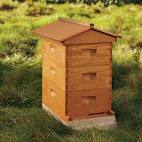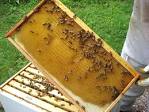In Part I of this series, I discussed the importance of pollinators to our food supply and the theories surrounding the alarming decline in their population. In Part II, I outlined ways in which we could improve local land use and land use policies to support native pollinator populations. Here in Part III, I will discuss my increasingly conflicting thoughts on beekeeping.
 I am a beekeeper. Four years ago I started work on small farm west of Carrboro where I grow vegetables, raise chickens, and engage in my farmer-engineer hobby of building things like solar power stations, greenhouses, water towers, and most recently an outdoor, upside-down, hydroponic tomato station. Before getting started on the farm, I did quite a bit of research on best practices in small-scale, sustainable farming. Many of the resources recommended installing honey bee hives on site.
I am a beekeeper. Four years ago I started work on small farm west of Carrboro where I grow vegetables, raise chickens, and engage in my farmer-engineer hobby of building things like solar power stations, greenhouses, water towers, and most recently an outdoor, upside-down, hydroponic tomato station. Before getting started on the farm, I did quite a bit of research on best practices in small-scale, sustainable farming. Many of the resources recommended installing honey bee hives on site.
This was an easy sell for me. Honey bees are absolutely fascinating. I could write another column in this series devoted solely to their life cycle and social habits. However, as this series is already long enough, I’ll cover just one for fun, the life cycle of the queen.
Every honey bee hive has a single queen. Soon after she is born, she leaves the hive for a brief time during which she has multiple interludes with male bees from other hives. During this sojourn, she stockpiles sufficient sperm to fertilize the eggs for the tens-of-thousands of offspring she will have over her four-to-five-year life span. This is the only time during her life that she will leave the hive, so let’s hope the gentlemen bees treat her well.
As the queen nears the end of her life, the other bees can sense it and will set to work “making” four to five new potential queens. For now, let’s refer to them as princesses. I put “making” in quotations because at the time they are born the princesses are no different than any other female bee in the hive. They are converted into queens by the nursery bees that provide them a special type of enriched honey as they grow within their cell in the hive. Then a race begins: a death race. The first of the princesses to emerge from her cell, in her very first act in life, kills all of the other princesses as well as the old queen in order to take over her new realm – a fascinating if somewhat macabre practice.
But I digress. If you are not familiar with beekeeping, here is the nickel summary. In the springtime, you can purchase a package of bees from a supplier such as Bailey Bee Supply in Hillsborough. The package is a small wooden box with screens on the sides which contains approximately 10,000 bees and one queen bee. After getting home from the store, you take your package of bees and dump them into a hive which usually looks like the one pictured at the top of this column. Doing this for the first time can be a bit intimidating, but honey bees are really quite docile. Inside the bee hive are frames which are shown in the picture next to this paragraph.  The frames have wax templates with hexagonal shapes to give the bees a head start on their new home. Most beekeepers provide sugar solution to new hives for a few weeks until the bees get established and start collecting enough nectar from nearby flowers to be self-sufficient.
The frames have wax templates with hexagonal shapes to give the bees a head start on their new home. Most beekeepers provide sugar solution to new hives for a few weeks until the bees get established and start collecting enough nectar from nearby flowers to be self-sufficient.
Over the past three years I have installed five packages of bees at my farm. The longest that any of my hives has lasted is 18 months. Two weeks ago I installed two new packages. While I hope that these two hives thrive for many years, I am pretty sure these will be the last packages of bees that I purchase. Here’s why.
Over the past year or so, I have begun to have mixed feelings about beekeeping. Essentially all packages of bees sold in the United States are Italian Honey Bees, an invasive species, and the queens are bred from a gene pool which keeps getting smaller and smaller. I have also found that my goals for beekeeping are not aligned with what the authors of beekeeping books are emphasizing. Beekeeping books tend to focus on maintaining the health of the hive and eventually collecting honey and beeswax. My beekeeping goals are to enjoy the bees’ fascinating behavior and support the growth in population of pollinators in the local area. What I would like to do with my honey bees is to have them continue to propagate on their own and establish more and more new hives in the local area. I have read how this can be done by purchasing a new queen and manually splitting the hive in two. I would much rather find a way to help the bees do it on their own. As yet, I have not figured out how. If any reader has a suggestion, please email me.
While I am moving away from beekeeping, that doesn’t mean that you should. I have yet to find reports that Italian Honey Bees are creating any of the typical problems associated with invasive species, and we need all the pollinators we can find. But what we really need is for our local apiary shops to start stocking packages of native bees in addition to the Italian imports. For my part, as I discussed in Parts I and II, my efforts will be on supporting native species from here on out. Look for updates over the summer.
Have a comment or question? Use the interface below or send me an email to commonscience@chapelboro.com.




Comments on Chapelboro are moderated according to our Community Guidelines